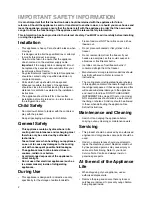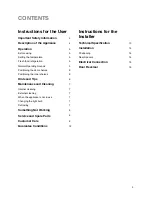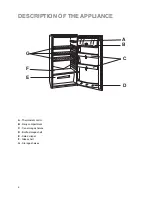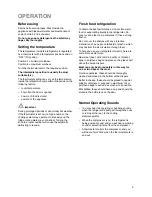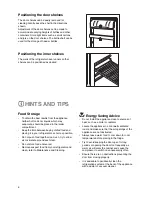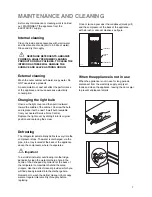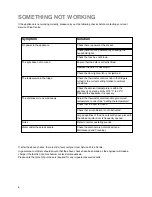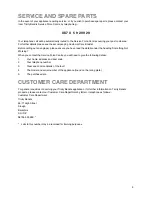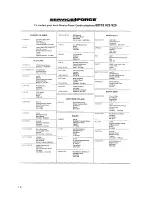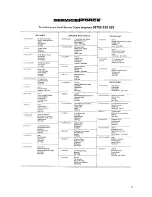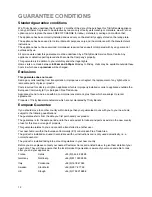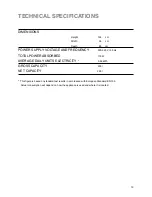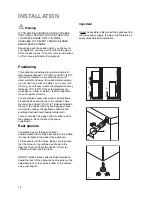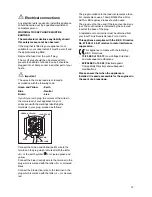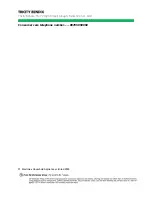
7
MAINTENANCE AND CLEANING
External cleaning
Wash the outer cabinet with warm soapy water. Do
NOT use abrasive products.
An accumulation of dust will affect the performance
of the appliance and cause excessive electricity
consumption.
Before any maintenance or cleaning work is carried
out, DISCONNECT the appliance from the
ELECTRICITY supply.
Internal cleaning
Clean the inside and accessories with warm water
and bicarbonate of soda (5ml to 0.5 litre of water).
Rinse and dry thoroughly.
NEVER USE DETERGENTS, ABRASIVE
POWDERS, HIGHLY PERFUMED CLEANING
PRODUCTS OR WAX POLISHES, TO CLEAN THE
INTERIOR AS THESE WILL DAMAGE THE
SURFACE AND LEAVE A STRONG ODOUR.
When the appliance is not in use
When the appliance is not in use for long periods,
disconnect from the electricity supply, empty all
foods and clean the appliance, leaving the doors ajar
to prevent unpleasant smells.
Once or twice a year dust the condenser (black grill)
and the compressor at the back of the appliance,
with a brush or vacuum cleaner, see figure.
D273
CONDENSER
COMPRESSOR
DEFROST
TRAY
Changing the light bulb
Unscrew the light cover and then pull it outward
toward the middle of the cabinet. Unscrew the bulb
and replace it with a new 15 watt bulb (available
from your nearest Service Force Centre).
Replace the light cover by sliding it into its original
position and replacing the screw.
Defrosting
The refrigerator automatically defrosts every time the
compressor stops. The water is discharged, via the
pipe, into a tray located at the back of the appliance
above the compressor, where it evaporates.
Important
To avoid defrost water overflowing into the fridge,
periodically clean the water discharge hole in the
centre of the V shaped drip collector at the back of
the refrigerator compartment behind the salad
crispers. Use the defrost cleaner provided which you
will find already inserted into the discharge hole.
Remember to wash the defrost cleaner in hot soapy
water at regular intervals. Dry throughly before
replacing.
D411
D037
14
INSTALLATION
Positioning
This appliance is designed to operate in ambient
temperatures between 10¡C (50¡F) and 32¡C (90¡F).
It should be located in a dry atmosphere, out of
direct sunlight and away from extreme temperature
e.g. not next to a boiler or radiator, or in a very cold
room e.g. an outhouse, where the temperatures may
fall below 10¡C (50¡F). If these temperatures are
exceeded i.e. colder or warmer, then the appliance
may not operate correctly.
You should also ensure that air can circulate freely
around the back and the top of the cabinet. There
must also be at least 100 mm (4Ó) distance between
the top of the cabinet and any overhanging kitchen
furniture (A). Ideally, the appliance should not be
positioned beneath overhanging furniture (B).
There should also be a gap of 25 mm either side of
the appliance. Do not obstruct the space
underneath.
Rear spacers
The plastic bag containing all relevant
documentation also contains two spacers to be fitted
into special holes in the back of the appliance.
Fit the spacers into the holes, taking care to ensure
that the arrow (A) is positioned as shown in the
diagram. Then turn them through 45¡ (arrow (A)
vertical) until they lock into place.
DO NOT install in places with restricted ventilation.
Adjust the level of the appliance by screwing out the
adjustable foot, or feet, at the bottom of the cabinet
using your fingers.
D200
Warning
IF YOU ARE DISCARDING AN OLD APPLIANCE
THAT HAS A LOCK OR CATCH ON THE DOOR,
YOU MUST ENSURE THAT IT IS MADE
UNUSABLE TO PREVENT YOUNG CHILDREN
BEING TRAPPED INSIDE.
Depending upon the position which you choose for
your appliance, you may wish to reverse the way in
which the door opens. To do this, refer to instructions
on ÒDoor reversal directionsÓ paragraph.
PR60
A
45
°
Important
It must be possible to disconnect the appliance from
the mains power supply; the plug must therefore be
easily accessible after installation.
100 mm
10 mm
10 mm
A
B
NP007


